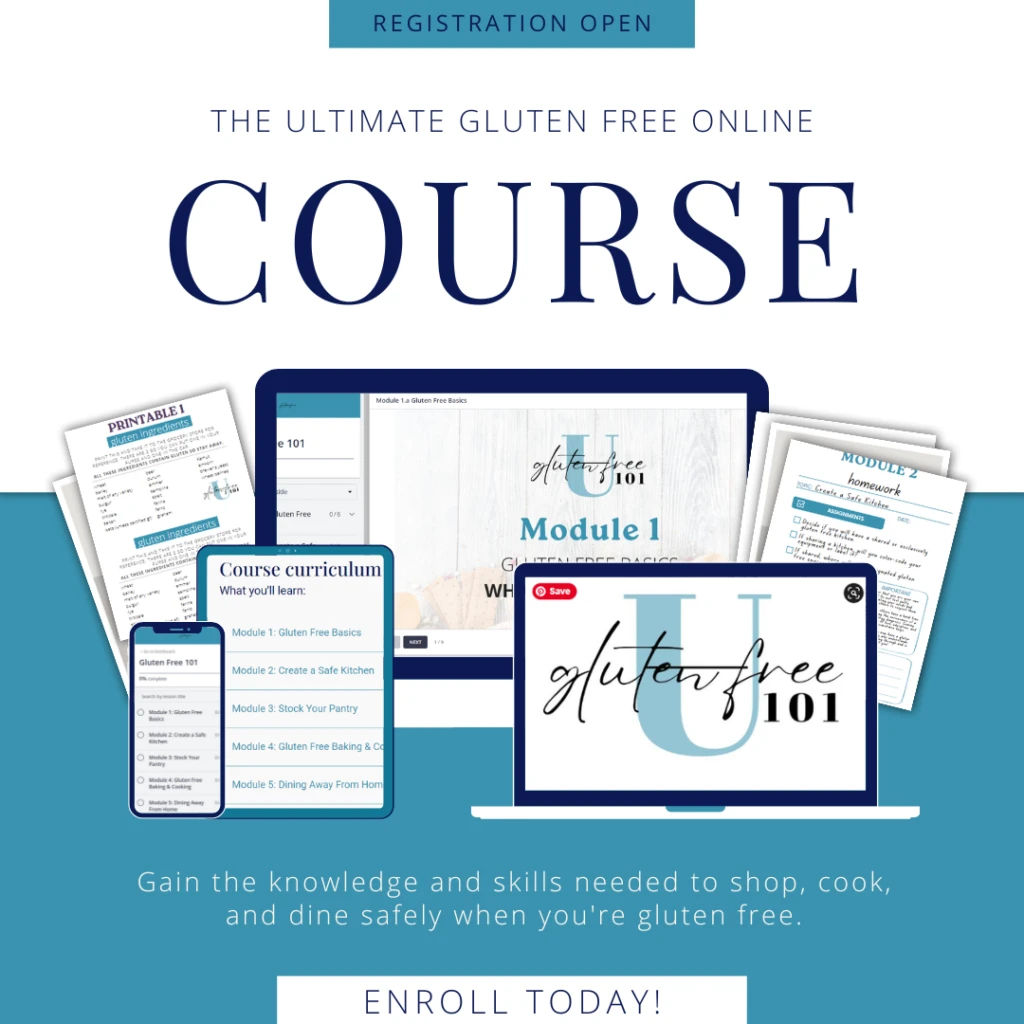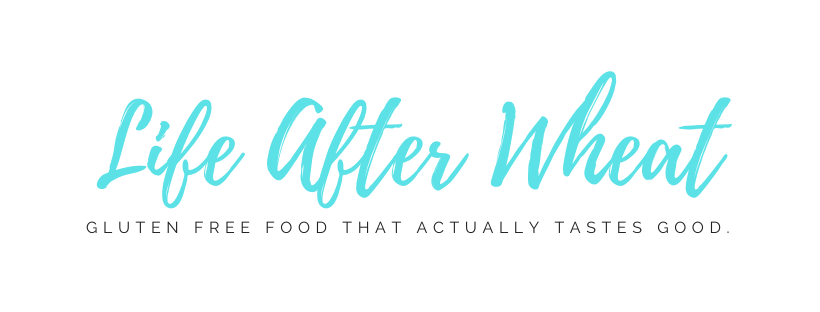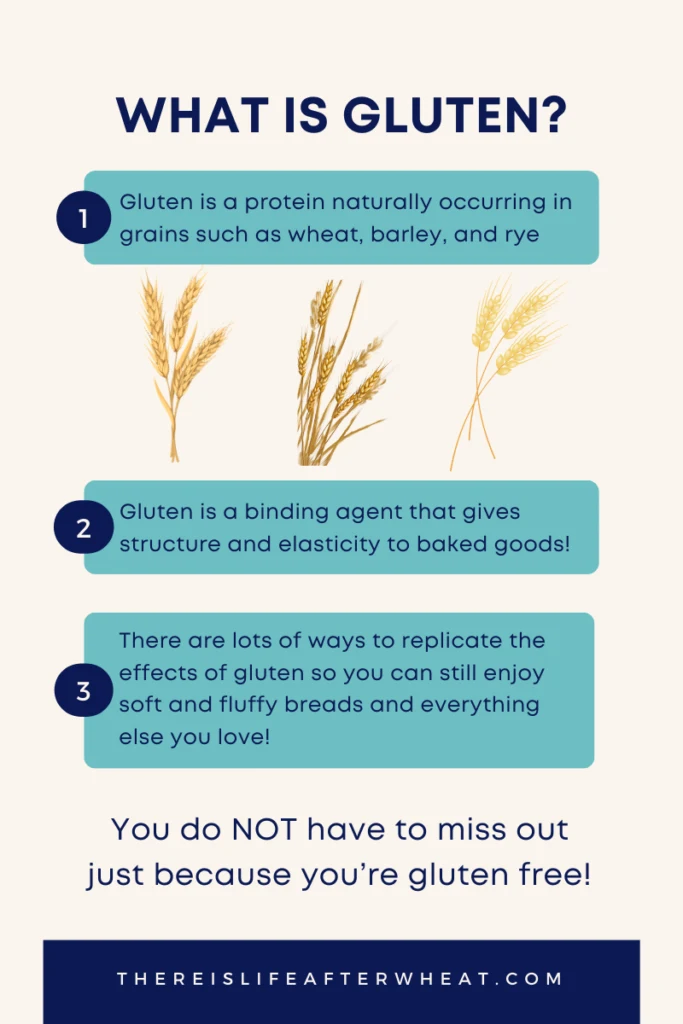Finally, someone to walk you through the first steps of a gluten free lifestyle! Gain the knowledge and skills needed to shop, cook, and dine safely when you’re gluten free.
Living a gluten-free lifestyle has gained popularity in recent years, whether due to health concerns or personal dietary choices.
If you’re considering going gluten-free or have recently been diagnosed with celiac disease, this blog post will provide all the information you need to embark on this journey and thrive in your gluten-free life.
From understanding gluten to navigating the grocery store and dining out safely, we’ll cover it all.
Let’s dive in!
Psst! New to gluten-free? I would love to help! Get a free lesson in my course, Gluten Free 101.
Table of Contents
Reasons for a Gluten-Free Diet
There are many reasons why people adopt a gluten-free diet. Some of the common reasons include:
- Celiac disease, an autoimmune disease that causes the body to mount an immune response when gluten is ingested.
- Non-celiac gluten sensitivity (sometimes called gluten intolerance), where consuming gluten leads to abdominal pain and other digestive symptoms
- Wheat allergy, an allergic reaction specifically to wheat.
- Autoimmune diseases such as Hashimoto’s thyroiditis or rheumatoid arthritis, where a gluten-free diet may be beneficial.
- Health and wellness trends, as some individuals believe that reducing or eliminating gluten can lead to improved energy levels, weight loss, or overall well-being.
For the purpose of this article, I’ll be directing the conversation toward those with celiac disease.
If you’re following a gluten-free diet for any other reason, the information will still be relevant to you but you may not need to be quite as strict in your avoidance of gluten.
What is Gluten?
Gluten is a protein naturally occurring in grains such as wheat, barley, and rye. It is a binding agent that gives dough its elasticity and helps it rise.
Without gluten, food products can be dry, crumbly, and dense.
Over the years, gluten-free foods have gotten a bad rap because many of them just didn’t taste good.
But don’t you worry! There are lots of gluten-free alternatives that can provide the same structure and texture.
While many people have resigned themselves to settling for foods that taste like cardboard, it is absolutely possible for you to still enjoy all your favorites while eating gluten-free!
And you can still enjoy a social life, too.
Read on to find out how!
Understanding Food Labels
One of the initial challenges of a gluten-free lifestyle is navigating the grocery store. Reading labels becomes essential to identify gluten-containing ingredients.
There is so much to cover here, which is why I have an entire module dedicated to labeling laws and how to read labels in my course Gluten Free 101, but here are the basics.
The Food and Drug Administration is the governing body over labeling laws in the USA, and requires that a food product clearly state the presence of any of the top 9 food allergens, which are:
- Tree Nuts
- Milk
- Peanut
- Egg
- Wheat
- Soy
- Fish
- Crustacean Shellfish
- Sesame
This is important, because wheat contains gluten. You will notice however, that gluten is not required to be stated on a food label so vigilance is key.
How do I know if a product is gluten-free?
The easiest way to tell if a food is gluten-free is to look for a “gluten free” statement on the packaging.
If a product has a “certified gluten free” seal from GFCO or another reputable organization, then you know the product has been tested to ensure it is safe.
If a product does not have a gluten-free certification or state that it is gluten-free, it could still be safe to consume. Scan the ingredients list for wheat, rye, and barley, which all contain gluten and are not suitable for those following a gluten-free diet.
Keep an eye out for tricky ingredients like malt, malt extract, and malt syrup which is sourced from barley and contains gluten.
An absence of gluten-containing ingredients does not mean a product is a gluten-free because there could be cross contamination (see below)
Surprising Sources of Gluten
Besides the obvious sources like wheat flour, there are some tricky places gluten hides! Watch out for some of these gluten-containing products:
- Condiments such as BBQ sauce, soy sauce, and salad dressings (malt often hides in these!) may or may not be safe.
- Products that contain oats. While oats are naturally gluten-free, they’re often cross-contaminated through the growing and packaging process. Look for certified gluten-free oats that are also purity protocol for the safest option.
Cross Contamination
Cross contamination, or cross contact, happens when an otherwise gluten-free food comes in contact with gluten.
Those with celiac disease must maintain a strict gluten-free diet and therefore need to be aware of cross contamination risks.
Cross contamination can happen on food production and packaging lines, as well as in food preparation and serving areas.
It’s important to ask brands and restaurants about their procedures for avoiding cross contamination so you can make a decision about whether it is safe for you to consume their products.
Gluten-Free Baking Tips
Gluten-free baking can require some adjustments to achieve the desired results. Here are a few tips to help you master gluten-free baking:
- Use a blend of gluten-free flours and starches instead of one flour such as rice flour
- Use xanthan gum and/or psyllium husk as a binding agent to replace the elasticity provided by gluten (most gluten-free flour blends contain xanthan gum)
- Instead of trying to adapt your own recipes right away, start with a recipe already developed to be gluten-free and use the flour recommended in the recipe.
Dining Away from Home Safely
Maintaining a gluten-free diet while dining out can seem challenging, but with the right knowledge and communication, it is possible. Here are some tips to ensure a safe dining experience:
- Inquire about gluten-free options when making a reservation or upon arrival at the restaurant.
- Communicate your dietary needs to the server and ask about cross-contamination prevention measures.
- Utilize online resources and apps that provide information about gluten-free-friendly restaurants in your area.
I have a printable dining script and lots more info on this in my course Gluten Free 101!

Challenges and Solutions
As you embrace a gluten-free lifestyle, you may encounter a few challenges. It’s important to be aware of these challenges and have strategies to overcome them. Some common challenges include:
- Difficulty finding gluten-free products: Explore specialty stores or online retailers that offer a wide range of gluten-free options. Shop the edges of the grocery store to find foods that are naturally gluten-free.
- Higher cost of gluten-free foods: Plan your meals, buy in bulk, and experiment with homemade alternatives to save on costs.
- Cross-contamination concerns: Keep separate utensils, cutting boards, colanders/strainers, and dedicated gluten-free areas in your kitchen to prevent cross-contamination.
- Dining out challenges: Do your research and don’t be afraid to communicate your needs!
- Ensuring nutritional balance in a gluten-free diet: Incorporate a variety of gluten-free whole grains, fruits, vegetables, and lean proteins to maintain a balanced diet. Try to up your intake of leafy greens and grains such as buckwheat and teff that are high in iron and b vitamins.
Gluten-Free Beginner-Friendly Recipes
To kick-start your gluten-free journey, here are a few beginner-friendly recipes to get you inspired:
Gluten Free Mac and Cheese Review
Panera Bread 10 Vegetable Soup Recipe (copycat)
Gluten Free Chocolate Chip Cookies
How to Make Gluten Free Bread That Actually Tastes Good (digital cookbook)
How to Make Gluten Free Bread That Actually Tastes Good (paperback cookbook on Amazon)
Conclusion
Congratulations on taking the first steps toward a gluten-free lifestyle!
Remember, resources like dieticians, online courses such as “Gluten Free 101,” and support groups can provide additional guidance and support.
Enjoy exploring new flavors, experimenting in the kitchen, and discovering the many delicious possibilities of a gluten-free lifestyle. Reach out to my anytime via the comments section or social media, I’m always happy to help!

